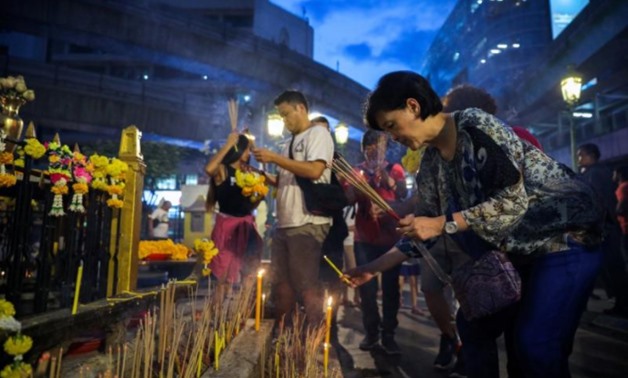
FILE PHOTO: Tourists pray at Erawan Shrine, a Hindu shrine popular among tourists in central Bangkok, Thailand, October 16, 2017. REUTERS/Athit Perawongmetha/File Photo
BANGKOK - 20 October 2017: For decades since the Vietnam war, the scantily clad dancers in the go-go bars of Bangkok’s Patpong red-light district have been the face of Thailand’s tourism industry.
But last year for the first time, the country drew more women tourists than men as a surge in Chinese female visitors outweighed a longstanding distortion spurred by men drawn to the world’s “sex capital”.
The shift is welcome news for Thai authorities, who have tried to promote the country’s shopping, beaches and temples and to minimize the importance of sex tourism, which thrived after Thailand became an R&R hotspot for U.S. troops in the 1960s and 1970s.
Tourism ministry figures reviewed by Reuters showed 52 percent of more than 32 million visitors last year were women.
That compared to 48 percent in 2015 and only 42 percent in 2012. No earlier official data were available, but research from as far back as the 1980s shows a ratio of about 60 percent male to 40 percent female visitors.
“Not as many women visited Thailand because they thought we were a cheap destination with too much vice, but now more are coming, which means our image accommodates them,” Tourism Minister Kobkarn Wattanavrangkul told Reuters.
Tourism accounts for around 12 percent of Southeast Asia’s second-biggest economy and is easily the fastest growing sector, particularly since a coup in 2014.
Hoping to attract more female tourists, the state’s Tourism Authority of Thailand started a “Women’s Journey” campaign last year, with a website and mobile application offering discounts for hotels, spas, malls, and restaurants.
But the biggest factor has been tourism from China, which has reshaped the industry around the world.
The number of Chinese visitors rose from nearly 12 percent of Thailand’s visitors in 2012 to 27 percent last year. The number of Chinese women visiting Thailand nearly quadrupled over the same period to more than 5.3 million.
“When Chinese men make a lot of money, they tend to take their wife, daughter, and mother to travel, making the ratio heavier on the female side,” said Virat Chatturaputpitak, vice president of the Association of Thai Travel Agents.
Major Chinese travel website Tuniu reported that 62 percent of its customers last year were women, Chinese media reported.
CHEAP, EASY AND CLOSE TO HOME
“I chose to come to Thailand because it’s close by, there are many flights, it’s cheap to travel and easy to get a visa,” said Man Na Zhang, 24, at Bangkok’s Erawan Shrine, a favorite spot for Chinese tourists despite a deadly bombing in 2015.
Chinese female visitors, who get a tourist visa on arrival, also cited a simple tax rebate procedure on duty free goods as another drawcard as they snap up items such as cosmetics, bottled bird’s nest soup, vitamins and supplements.
Many stores in Bangkok’s shopping malls now accept Alipay, China’s giant online payment service. A Big C supermarket near the Erawan shrine buzzes with Chinese tourists who fill their trolleys with bulk packets Tom Yum Goong flavored instant noodles, crispy seaweed and dried squid snacks.
Businesses in tourist towns have started printing menus in Chinese and getting workers to learn the language to cater to Chinese tourists, who last year made up more than those from Europe, the Americas, the Middle East and Africa combined.
China’s recent “Golden Week” holiday brought 70 percent more Chinese visitors than last year, the tourism ministry said.
For nationalities that traditionally patronized Thailand’s sex industry, tourist numbers are still dominated by men - 68 percent of Japanese visitors, 58 percent of British and nearly 56 percent of American, Australian and German tourists.
But even for those countries, the balance has shifted more towards female tourists.
Although the sex industry is far from dead, local businesses complain fewer tourists were visiting areas such as Patpong and nearby Silom neighborhood.
“There are evidently fewer tourists, especially in the low season, when sales can go from tens of thousands of baht a day to nothing,” said Somkid Sangwong, a manager of a restaurant in a Silom alley next to Patpong, surrounded by neon-lit signs for bars blasting loud music and offering raunchy live shows.
Phadet Mesild, a board member of the Tourism Association of Koh Samui, another popular spot for sex tourism, told Reuters the decline in demand had forced many venues in the island to close down.
Since 2014, Thailand’s military government has occasionally raided brothels, bars, and massage parlors in an effort to clean up the country’s image, but they have usually bounced back quickly.


Comments
Leave a Comment